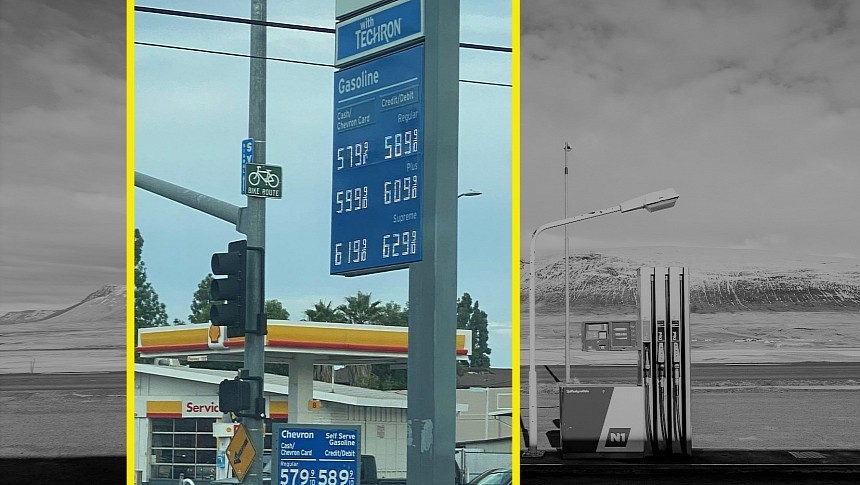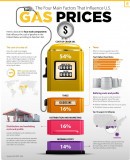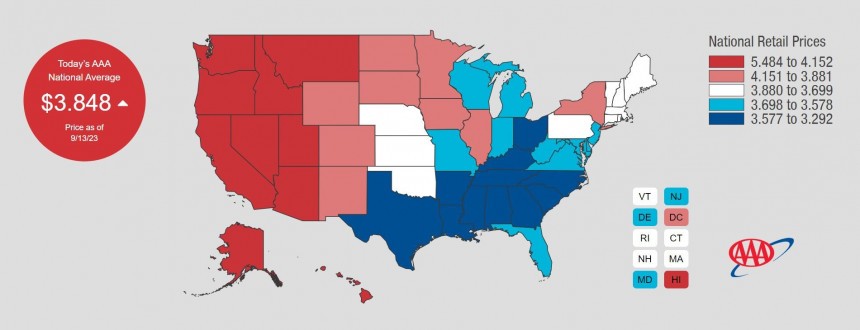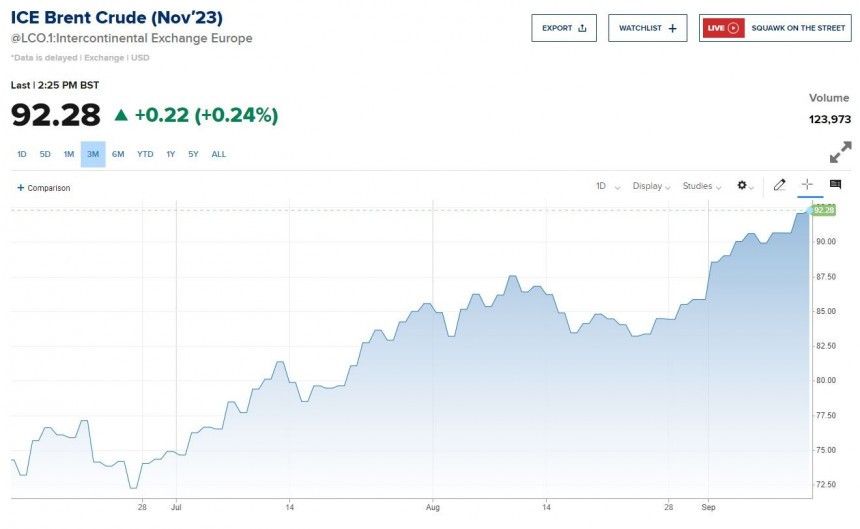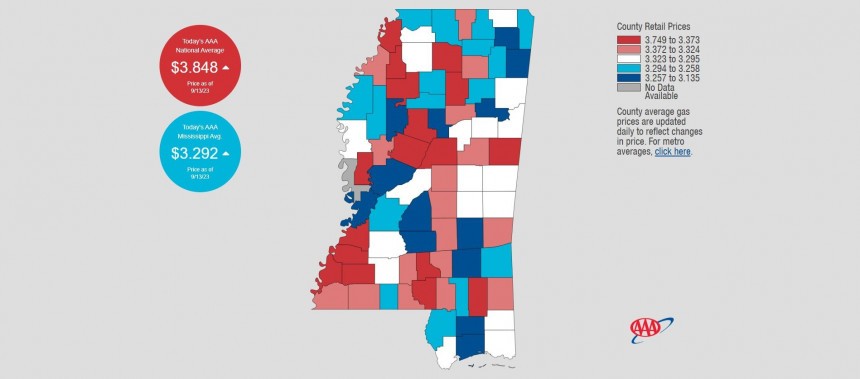Just as we thought that inflation would cool down a bit and take some pressure off the increased cost of living, gas prices come out of nowhere with a sucker punch and make most of us feel just a little bit more overwhelmed. But here are the things you must know about the fluctuating pump figures. It'll help you not fall for any political shenanigans.
In California's Mono County, the average price people see when visiting the gas station is $6.33 per gallon. But it gets even worse in neighboring Alpine, where the median cost of a gallon of fuel is $6.99.
Americans living in these parts of the Golden State would be better off filling up in Madera and Tuolumne counties. That's where gas is still sold at an average of $5.3 per gallon.
To put these prices into context, Mississippians living in Yazoo and Stone counties enjoy an average gas price of $3.1 per gallon when writing. Living in California indeed has its perks, but if your garage comprises more than one fossil fuel-hungry car… Things won't look very good when budgeting the monthly expenses.
But it's not just Californians experiencing these increases. Washington, Alaska, Nevada, Arizona, Utah, Hawaii, and even Idaho residents are seeing increased values for regular gas. If your vehicle requires refined dinosaur juice of higher octane, you're in even more trouble because those types of fuels are costlier. On average, the price moves upward in $0.40 increments.
So, why is this happening?
First, the price the customer sees at the pump is influenced by four main factors – the price of crude oil (54%), taxes (16%), distribution plus marketing (16%), and refining (14%).
However, the US is also the country that consumes the most oil derivatives. As such, decoupling from the international oil market is impossible, even though the US is not a member of the cartel-like Organization of the Petroleum Exporting Countries (OPEC).
Earlier this month, we were telling you how Saudi Arabia and its ally Russia are singlehandedly accelerating EV adoption in North America and Europe. The two countries have further extended the daily oil output cuts by millions of barrels. That sent traders into a frenzy, and futures prices rose immediately.
In layman's terms, that meant gas was about to get more expensive for us all because sellers and buyers started agreeing on higher prices since supply wasn't going to overcome demand any longer. This situation is expected to continue until 2024 because OPEC decided to maintain the artificial output cuts until the end of 2023, while Saudi Arabia and Russia doubled down with voluntary reductions of their own.
The two main indexes – WTI and Brent – measure, among others, the average price of trading 600,000 barrels of crude oil. That's 25,200,000 gallons!
In July 2023, WTI was sitting at around $70. When writing, it's at almost $89.
On the other hand, Brent had a price of approximately $74, which rose to over $92 at the time of writing.
That tells us that crude oil is simply going to be even more expensive than it currently is because WTI (US-focused) prices are negotiated a month in advance, while Brent (global) is even more forward-looking – what's established in September will be felt by retail customers in November.
Californians are paying the most because the state has the highest tax on refined fuels. When filling up, Americans living in the Golden State are paying $0.87 just in taxes, whereas the national average is about $0.57.
Mississippi, on the other hand, asks for just $0.19 per gallon in gas tax.
Since gas and diesel are getting pricier, distribution will cost more because it is not happening with the help of Tesla Semi-like haulers. That's the other factor that increases the figures buyers see at the pump.
Refining is the last main factor that impacts the cost of fuel. Some facilities closed in 2020 and did not return to normal operations after the global health crisis ended. But their absence has been covered by other industry players, so US refining is not affected in any meaningful way. It's not contributing to increased pump numbers.
All the above leaves us with a simple conclusion - the leading cause of crude oil becoming more expensive is OPEC wanting it to be so.
Moreover, this behavior is a significant problem for the White House because the current administration was trying to cut off Russia from foreign funding. Now, thanks mainly to US ally Saudi Arabia, that's even more complicated. The belligerent country is getting even more money.
"The index for gasoline was the largest contributor to the monthly all items increase, accounting for over half of the increase," explained BLS in a statement.
Overall, the US isn't doing anything wrong, and no natural phenomena threaten the federal refining capacity. It's just OPEC's and the group's allies' fault.
The uptrend will only continue from here unless the White House decides to once again release millions of barrels of oil from the strategic reserve. Sadly, that seems to be unfeasible because the stocks are at nearly half the 2021 capacity.
Americans living in these parts of the Golden State would be better off filling up in Madera and Tuolumne counties. That's where gas is still sold at an average of $5.3 per gallon.
To put these prices into context, Mississippians living in Yazoo and Stone counties enjoy an average gas price of $3.1 per gallon when writing. Living in California indeed has its perks, but if your garage comprises more than one fossil fuel-hungry car… Things won't look very good when budgeting the monthly expenses.
But it's not just Californians experiencing these increases. Washington, Alaska, Nevada, Arizona, Utah, Hawaii, and even Idaho residents are seeing increased values for regular gas. If your vehicle requires refined dinosaur juice of higher octane, you're in even more trouble because those types of fuels are costlier. On average, the price moves upward in $0.40 increments.
First, the price the customer sees at the pump is influenced by four main factors – the price of crude oil (54%), taxes (16%), distribution plus marketing (16%), and refining (14%).
The numbers tell the true story
But you might have heard that the US is the world's largest oil producer. That might suggest that America shouldn't be influenced by what happens globally.However, the US is also the country that consumes the most oil derivatives. As such, decoupling from the international oil market is impossible, even though the US is not a member of the cartel-like Organization of the Petroleum Exporting Countries (OPEC).
Earlier this month, we were telling you how Saudi Arabia and its ally Russia are singlehandedly accelerating EV adoption in North America and Europe. The two countries have further extended the daily oil output cuts by millions of barrels. That sent traders into a frenzy, and futures prices rose immediately.
The two main indexes – WTI and Brent – measure, among others, the average price of trading 600,000 barrels of crude oil. That's 25,200,000 gallons!
In July 2023, WTI was sitting at around $70. When writing, it's at almost $89.
On the other hand, Brent had a price of approximately $74, which rose to over $92 at the time of writing.
It will keep getting worse
The next factor that influences gas prices – taxes – has not changed.Californians are paying the most because the state has the highest tax on refined fuels. When filling up, Americans living in the Golden State are paying $0.87 just in taxes, whereas the national average is about $0.57.
Mississippi, on the other hand, asks for just $0.19 per gallon in gas tax.
Since gas and diesel are getting pricier, distribution will cost more because it is not happening with the help of Tesla Semi-like haulers. That's the other factor that increases the figures buyers see at the pump.
All the above leaves us with a simple conclusion - the leading cause of crude oil becoming more expensive is OPEC wanting it to be so.
Moreover, this behavior is a significant problem for the White House because the current administration was trying to cut off Russia from foreign funding. Now, thanks mainly to US ally Saudi Arabia, that's even more complicated. The belligerent country is getting even more money.
Don't buy that new phone yet
The Bureau of Labor Statistics (BLS) also confirmed that high gas prices are not helping with the fight against inflation. If it's any consolation, that's a bigger problem in Europe. Fuels are taxed even higher over the pond."The index for gasoline was the largest contributor to the monthly all items increase, accounting for over half of the increase," explained BLS in a statement.
Overall, the US isn't doing anything wrong, and no natural phenomena threaten the federal refining capacity. It's just OPEC's and the group's allies' fault.
The uptrend will only continue from here unless the White House decides to once again release millions of barrels of oil from the strategic reserve. Sadly, that seems to be unfeasible because the stocks are at nearly half the 2021 capacity.
